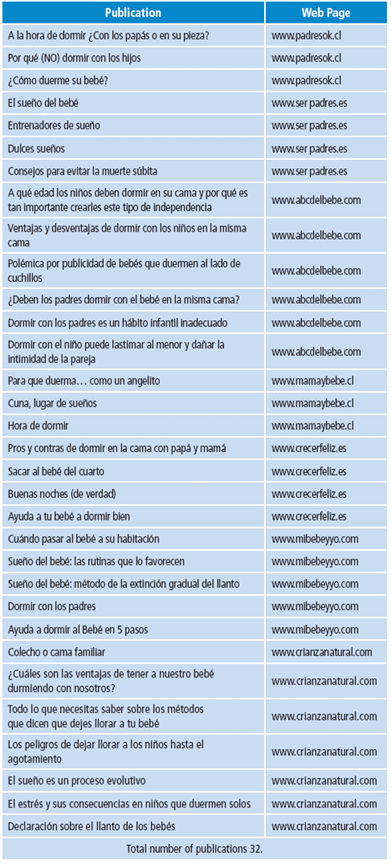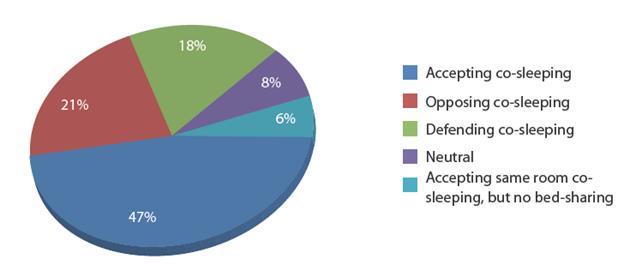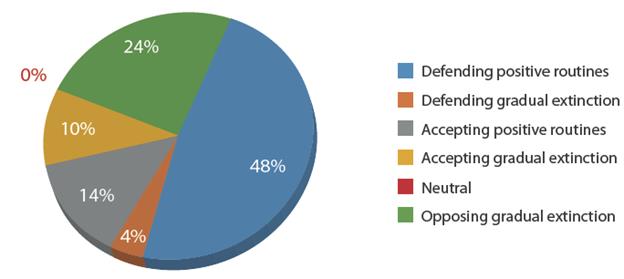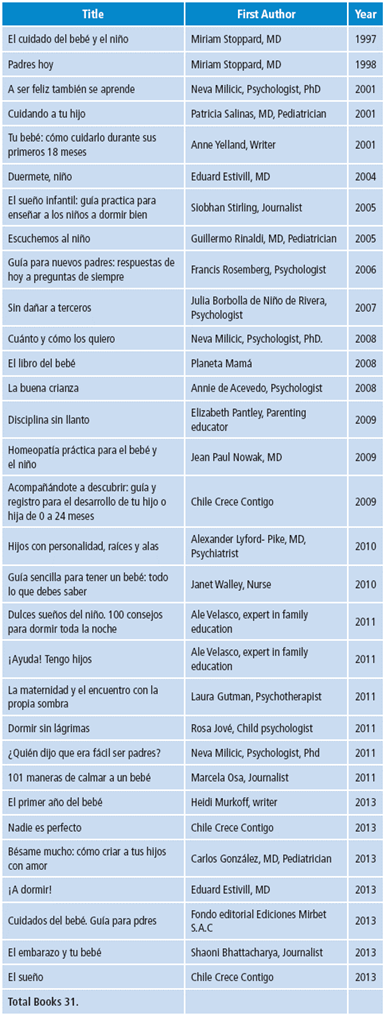Introduction
Raising children is a relevant activity in different societies and, for centuries, experts have offered advice on how to raise them with the aim of helping parents achieve goals according to the principles, values and popular models of their own cultures 1,2. In this context, "children should adapt to their culture, and their care-givers should attempt to raise them according to what they envision as an ideal child" 1; hence, diverse issues involved in raising children, such as sleep patterns, eating schedules, social attitudes, among others, are gradually shaped according to the requirements 3,4.
The different styles for raising children have gradually changed over the years, only becoming more visible in the last century 5, when parents facing child rearing began to look for expert advice in different sources, finding a variety of books, magazines, videos and television programs addressing this topic 6. Simultaneously, the amount of publications aimed at parents related to issues in child rearing increased, as well as the interest in analyzing these publications, so as to describe and understand trends, arguments and cultural changes in child rearing and the diverse aspects implicated in this process 6-8.
Literature review
Child sleep
One of the key issues of raising children, and a controversial topic in existing publications, is sleep in infants 6,9,10. The diverse information evidences the influence of cultural patterns and the historical variation in the understanding and management of child sleep; it is clear that the current debate at a global level shows the huge responsibility that parents have when facing the challenges posed by this practice 11.
Advice for parents on child sleep: Co-sleeping and sleep training
Different strategies and perspectives provided by different sources reflect two main positions regarding child sleep: sleep training and co-sleeping.
Sleep training is a method founded on behavioral psychology, in which sleeping is seen as a trainable habit 12,13. Different interventions can be observed within the context of sleep training, such as extinction, gradual extinction, feed-play-sleep cycles, as well as education on tired cues, sleep algorithms, overstimulation 14, controlled crying 15, positive routines, delay in sleep time, sleeping schedule and parent education.
This approach is grounded on two central aspects: 1) the training of parents to become active agents in inducing and improving child sleep, and 2) the incorporation of behavioral interventions, based on the principles of learning theory and behavior therapy, for example, reinforcement and extinction 16.
Many investigators support sleep training based on the alleged benefits in sleep, emotional and physical states of children 13,17,18 and their parents 12,18-20. Nevertheless, other researchers question the application of several of these techniques and warn against numerous negative consequences in the short, medium and long term, stressing the role played by culture and predominant paradigms that have ultimately defined what "normal" sleep is during the first year of life 14,21,22.
The second position, co-sleeping, is based on the principle that sleep is an evolutionary process, something that cannot be taught, but depends on the physiological development of children 23. The term "co-sleeping" can vary: while in some cultures babies and parents share the same bed, in others babies sleep on a surface separated from the parents, although within reach of each other 24.
In this paper, co-sleeping is defined as a sleep arrangement that allows a sensory bond between the baby and the adult caregiver, providing the latter with the opportunity to respond to the needs expressed by the baby 22. Many investigators concur that co-sleeping is the most adequate manner in which children should sleep 22-25, pointing out alleged benefits such as an improved mother-child relationship, better fulfillment of needs 26-28, cardiorespiratory stability, decrease in crying episodes 29, and a healthier sleep pattern 22.
However, and not surprisingly, adherents to learning theory and others disagree with co-sleeping and suggest detrimental consequences such as more nocturnal awakenings, interruption of sleep in both parents and children 16, a greater number of children with sleep problems, more dependent children, and negative repercussions for development 30.
Hence, an international debate is evident; both positions have their own supporters and adamant critics, and no agreement is in sight. Most of these publications, however, have been published by authors working in Anglo-Saxon cultures and, although cultural difference is often acknowledged, research on expert advice concerning sleep in other cultural traditions is still scarce.
This paper aims at analyzing the current situation in Chile, since child sleeping during the first year of life is a common issue among Chilean parents 31 due to the relevance that it represents for mental and physical health, as well as for the cognitive and social functioning of the child 32,33, his family 18, the increasing consultation of publications 6-8,11, and the scarce number of Latin-American studies about expert advice 1.
Objective
To describe the different positions found in publications offering advice to Chilean parents regarding sleeping in infants within the last two decades.
Materials and methods
This is an explorative study that describes and interprets publications aimed at and accessible to Chilean parents regarding sleeping habits in infants; it partially replicates the setup and methodology followed by Ramos and Youngclarke 6.
During the first phase of the study, a qualitative analysis of the content was conducted to subsequently conduct a quantitative content analysis aiming at establishing the frequency in which identified issues are presented in the written material 34.
Design
The study followed a mixed sequential derivative design 35, in which the collection and analysis of quantitative data were done based on qualitative results. Specifically, during the first stage, qualitative data were collected, followed by codification through assignment of codes to analytic categories in order to subsequently record the number of times each code appeared as numerical data. The convenience of using this type of design was evident in a similar study conducted by Ramos & Youngclarke 6 on related North-American literature.
Data collection
Sixty-three publications available in Chile and published between 1994 and 2014, written in Spanish, were analyzed. Books were selected based on the following criteria: main title or content referring to sleep in infants, publication between 1994 and 2014, directed to parents, commercially accessible (available for purchase on line, at supermarkets and libraries in Chile), and/or available for loan in libraries.
Book sample
For the identification and acquisition of books for parents, three methods were used:
Internet search using the "Google español" search engine and the web sites of large national bookstores selling Chilean and foreign books, such as "Buscalibros.cl", "Feria mix", "Feria Chilena del Libro" and "Librería Antártica", with the key words "books for parents" combined with "sleep", and "babies- children- nursing infants".
Visits by SVF to two bookstores located in shopping centers in Santiago, Chile; two bookstores located in the center of La Serena, Chile; two bookstores located in shopping centers in La Serena, Chile; a bookstore in a supermarket and two street book vendors in La Serena, Chile.
Visits to "Biblioteca Viva" (public library) located at the main shopping center in La Serena, Chile.
In addition, several books were added from a previous search on books regarding child rearing conducted by PC.
In consequence, 33 books were identified. The final sample was composed of 31 books since two books were difficult to purchase -although they were available online- therefore, the selection criterion "being commercially accessible to parents" was not met.
Table 1 shows the list of the 31 books analyzed, their first author, and the year of publication.
Sample of web page publications
Web pages aimed at parents were selected based on the key words "pages for parents", "advice for parents", and "upbringing". Once the web pages were found, the selection was done considering the following criteria: the country of origin of the web page had to be a Spanish speaking country, containing publications on nursing infants to sleep, published or created between 1994 and 2014 in a journal with a printed edition. A 3-month search period was established (April to June of 2014), identifying eighteen web pages; 10 web pages were selected after complying with all criteria established.
After the selection, references to infant sleep were sought in the search engine of each web page, through the keyword "sleep" combined with "nursing infant" and "babies", obtaining a list of 64 articles in seven of the 10 web pages selected. Such articles were reviewed to evaluate their inclusion in the sample, if there was an explicit reference on sleep in infants; articles about sleeping in children and/or adolescents, promoting products for sleeping, forums, and expert questions and answers were excluded from the sample
Since the web page crianzanatural.com contained 24 articles, a significantly greater number of articles than those found in other web pages, 7 articles were randomly chosen so as to avoid overrepresentation of this magazine in the results.
Finally, 32 publications were selected. Table 2 details the selected publications and the web page where they were found
Table 2 Selected publications and website.

Source: Own elaboration based on the data obtained in the study.
The 31 books and the 32 webpage publications together constituted a sample of 63 publications with advice on sleeping in infants, which were subsequently used to conduct both the qualitative and quantitative analyses.
Data Analysis
Co-sleeping was defined as the situation in which infants and caregivers share the same space to sleep, that is, the same bed (SB) or the same room (SR). Sleep training was defined as those strategies based on behavioral psychology principles that intend to modify behavior. All publications were read and classified into analytic categories, and a list of citations was obtained. Citations that did not match any of the categories previously defined were classified into new analytic categories defined by consensus. Once the codification of the positions and arguments on infant sleep (qualitative phase) was obtained, data was converted from text to numerical indices. A spreadsheet was filled with the information obtained to perform a descriptive statistical analysis.
Results
Co-sleeping
Each publication was categorized according to the degree of co-sleeping support into five levels (analytic categories):
Defense of co-sleeping: proposing co-sleeping as the best option and giving instructions and/or suggestions on implementation strategies.
Acceptance of co-sleeping: accepting co-sleeping as a viable option but under certain conditions.
Neutral: describing co-sleeping without defending it and/or only expressing advantages and disadvantages. Opposed to co-sleeping: clearly stating co-sleeping as an undesirable or damaging strategy.
Acceptance of co-sleeping in the same room, but not bedsharing: accepting same room co-sleeping as a viable option but not bed-sharing.
Out of 63 selected publications, 22% (n=14) did not mention co-sleeping; the different positions on co-sleeping found in the remaining 49 publications are shown in Figure 1.

Source: Own elaboration based on the data obtained in the study.
Figure 1 Description of the different positions on co-sleeping.
47% (n=23) of the publications accepted co-sleeping for a few months or under certain conditions, e.g., "Guía sencilla para tener un bebé" (Simple guide to having a baby) or "El cuidado del bebé y el niño" (Taking care of the baby and the child). Regarding this position, only one publication -"El sueño infantil" (Child sleep) - explicitly favored SB co-sleeping for a few months. Eleven publications favored both types of co-sleeping for a few months, e.g., "101 maneras de calmar a un bebé" (101 ways to calm down a baby) or "Guía sencilla para tener un bebé" (Simple guide to having a baby), and the remaining eleven accepted sharing the same space for sleeping (SR) during a certain period of time, e.g., "A qué edad los niños deben dormir en su cama y por qué es tan importante crearles este tipo de independencia" (At what age should children sleep in their own bed and why creating this type of independence is important) or "A la hora de dormir ¿Con los papás o en su pieza?" (Time to sleep. With parents or in their room?).
One example of SR is given by Salinas in his book "Cuidando a tu hijo" (Taking care of your child): "[...] most parents prefer having the baby in the same room during the first few months, which does not represent any problem, as long as it is for a limited period of time" (36, p84).
21% (n=10) of the publications were explicitly against co-sleeping -e.g., "La buena crianza" (The good upbringing), "¡Ayuda! Tengo hijos" (Help! I have children), and "Por qué (NO) dormir con los hijos" (Why (NOT) sleeping with children), mostly opposing SB: "[...] if your child is restless at night and cries, do not take him into your bed [...] that is only a temporary solution that will later bring many headaches" (37, p53).
18% (n=9) of the publications explicitly favored co-sleeping, considering it as the best option -e.g., "Dormir sin lágrimas" (Sleeping without tears) or "La maternidad y el encuentro con la propia sombra" (Maternity and finding your own shadow). Out of these publications, six defended SB co-sleeping, while three defended both types of co-sleeping: "[...] if we let mothers sleep with their babies as they wish -with two, four or eight people in the same bed- there will not be any problems with babies not sleeping" (38, p235).
8% (n=4) of the publications were neutral, allowing readers to choose their own option -e.g., "Ventajas y desventajas de dormir con los niños en la misma cama" (Advantages and disadvantages of sleeping with children in the same bed) or "Polémica por publicidad de bebés que duermen al lado de cuchillos" (Controversial publicity of babies sleeping next to knives). Finally, 6% (n=3) of the publications showed an explicit opinion on both types of co-sleeping, accepting SR co-sleeping and opposing SB co-sleeping -e.g., "Guía para nuevos padres: respuestas de hoy a preguntas de siempre" (Guide for new parents: today's answers to yesterday's questions).
All in all, 65% of the analyzed publications allowed some form of co-sleeping. However, most of them agreed on co-sleeping for just a few months.
Sleep Training
The analysis of sleep training methods initially focused on the gradual extinction strategy of sleep training, which was operationally defined as the extinction of crying related to sleep by not responding consistently, thus allowing the presence of the parents in the child's room while providing comfort based on a protocol.
After analyzing the literature, this definition was extended to include positive routines, defined as the fulfillment of a routine characterized by soothing activities enjoyed by the child during bedtime and associated with sleeping. Gradual extinction and bedtime routines are different, but share the idea of sleeping as a habit that should be learned.
Each publication was classified according to the degree of support to a strategy for sleep training, obtaining four levels of "gradual extinction" and three of "positive routines", namely, the defense of gradual extinction/ positive routines, the proposal of gradual extinction/ positive routines as the best option, and offering instructions and/or suggestions on how to implement it.
Publication accepting gradual extinction/positive routines favor gradualextinction/positiveroutines,but do not offer recommendations as to how to implement it; neutral publications present advantages and disadvantages on gradual extinction/positive routines or only present strategies without taking a stand; finally, publications against gradual extinction clearly express that this strategy is undesirable or damaging.
Out of 63 analyzed publications, 79% (n=50) mentioned strategies based on sleep training. The array of positions presented on sleep training are shown in Figure 2.

Source: Own elaboration based on the data obtained in the study.
Figure 2 Positions of publications on sleep training.
24 publications explicitly defended positive routines, presenting this strategy as the best option and offering suggestions on its implementation (e.g., "Who said being a parent was easy" or "The No Cry Discipline Solution"). For example, one of the publications shows the following text: "[...] when your baby is 6 or 8 weeks, start a fixed routine each night [...] some common elements include a bath, putting pajamas on, reading a story, cuddling, or playing a soothing game" (39, p73).
24% (n = 12) of the publications were against gradual extinction, suggesting it is a damaging strategy -e.g. "Sueño del bebé: método de la extinción gradual del llanto" (Baby sleep: graduated extinction method), "Dormir sin lágrimas" (Sleeping without tears) or "Todo lo que necesitas saber sobre los métodos que dicen que dejes llorar a tu bebé" (Everything you need to know about methods on cry-it-out): "[...] training methods do not teach how to sleep; they only cause emotional shock that alters the main hormones of the infant which are responsible for regulating emotions, also demonstrating that complaining is not worth it" (23, p217).
14% (n=7) accepted the use of positive routines, suggesting this strategy as a good option, without recommending how to implement it, e.g., "El primer año del bebé" (The first year of the baby) or "Dormir con los padres es un hábito infantil inadecuado" (Sleeping with parents is an inappropriate childhood habit): "parents can encourage individual sleep habits from an early age [...]. The younger the child, the easier it will be for him to become habituated" 40.
13% (n=5) of the publications favored sleep training, accepting gradual extinction -e.g., "El embarazo y tu bebé" (Pregnancy and your baby). 4% (n=2) defended gradual extinction showing it as the best option and offering details for its implementation - e.g.,"¡A dormir!" (Off to sleep!).
In conclusion, 76% of the analyzed publications were in favor of behavioral techniques, defending and/or accepting the strategies defined as sleep training. A greater tendency to defending and/or accepting positive routines rather than strategies based on cry-it-out, such as gradual extinction, was observed.
Arguments in favor and against the defended positions
Arguments in favor of co-sleeping
The most frequent arguments favoring co-sleeping are those related to meeting the needs of the children, that is, improvement of sleep in children and leaning toward lactation.
Arguments against co-sleeping
The most frequent arguments against co-sleeping suggest it is a dangerous strategy, which favors dependency, negatively alters the sleep of both children and parents, and interferes with the life of the parents as a couple.
Arguments in favor of sleep training
The most frequent arguments in favor of sleep training refer to improved sleep in children, the alleged autonomy related to independent sleep and the improvement of the sleep of the parents.
Arguments against sleep training
The arguments against sleep training oppose gradual extinction, stating that this strategy is stressful, alters the psychological health of the infant, and may cause permanent damage since the needs of the child are not met.
Mixed positions
Only few publications were outspoken; 14 took a strong stand, half of them defending co-sleeping and opposing sleep training, and half of them defending and/or accepting sleep training and opposing co-sleeping, while the remaining sources showed mixed positions. Most sources accepted co-sleeping for a few months and then switching to sleep training. Thirteen publications defended one of the positions without expressing an opinion on the other.
The remaining articles presented a combination of positions such as accepting co-sleeping for a few months and not expressing an opinion on sleep training; no position on co-sleeping and no opinion expressed on sleep training; acceptance of SR co-sleeping, while opposing SB co-sleeping and defending of positive routines; acceptance of SB and SB/SR co-sleeping, defense of positive routines and opposing sleep training, and defending positive routines, opposing sleep training and no opinion on co-sleeping.
Discussion
This study shows that Chilean parents are confronted with contradictory advice when seeking information about the regulation of infant sleep. Both book authors and website advisers favor either one or the other approach or allow different combinations, but a clear consensus is not available. Experts who favor sleep training advice a relatively mild introduction of "positive routines" instead of advocating for the "cry-it-out" approach, which is popular in other studies 6.
Unfortunately, these findings on contradictory advice in Chile are not an exception; in other countries, a large amount of available information on infant sleep can also be found, exposing the need that parents have for advice on sleep issues, while revealing, at the same, the interest of different professionals in publishing information and analyses on the topic 6,7,10,11,41,42. Parents looking to do "the right thing" are thus confronted with contradictory advice, which may enhance their confusion and insecurity in decision-making regarding their children 6,43,44.
For example, a study conducted by Davis 43 in England, in which 160 women were interviewed to gather information on their perception regarding upbringing after reading books intended for parents, reported that many parents were frustrated and felt "incompetent" and "confused" in view of the high standards diffused by books and the existing differences among recommendations given by experts.
The fact that Ibero-American experts clearly prefer the "positive routines" technique over "cry-it-out" procedures may be influenced by current views that defend positive parenting, seek to avoid any type of abuse, and try to make sure that children receive protection as they grow up in a loving and understanding environment 45,46. Moreover, it seems that the diverse information on infant sleep provides insight into the way how values and expectations in a particular society may define what is "correct" or preferable, and what is "incorrect", hence, not recommendable 22,42,43.
With this in mind, being clear on how cultural and historical processes shape different visions and existing arguments on sleep, the way they define how and where infants should sleep, and how these processes have influenced the expectations of parents about sleeping and their children 11 is necessary, as well as the advice that has been offered by pediatric sleep professionals 42.
The results of this study should be interpreted with some caution. Books and web sites reflect just part of the culture, and perhaps including magazines, newspapers, and television programs changed the general picture. Besides, books tend to be written for and read by higher socio-economic groups, and only webpages with a printed version were included, which may pose additional bias. Although the selection criterion was established with the purpose of supporting the finding based on material created by professionals or a recognized institution, this criterion is not commonly used by parents when conducting their research.
Furthermore, literature does not reflect what parents actually do in their daily lives 47. In this sense, professional advice to parents about infant sleep should consider social and cultural environments, beliefs, practices and community narrative in order to make these messages more effective 48.
Finally, the need for a more scientific study on the regulation of infant sleep, intended to provide parents with a more solid foundation to act upon, has been made evident by this study; it is also necessary to include parents by asking about their needs and preferences 15, as well as taking good notice of their intuitive ideas since their willingness to adopt new approaches depends on such needs and preferences. If an agreement is not reached by experts concerning the best method to regulate infant sleep, this should be openly communicated to the lay public.
Parents do well by reflecting on the suggested guidelines and realizing that they are subjected to sociocultural bias and fashion. With this considerations in mind, they may decide what advice they wish to incorporate into the upbringing of their children 7, evaluating the potential costs and benefits of the strategies they would eventually use 49.















